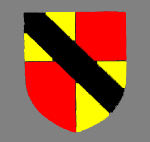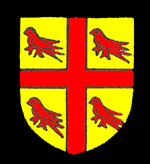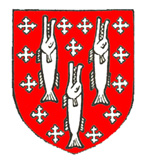The Manor of Wootton Hoo

The arms of the Barony of Bedford
Volume III of The Victoria County History for Bedfordshire was published in 1912. It gives detailed histories for each of the manors in Wootton. The Manor of Wootton was the principal manor in the parish, tracing its history back to the manor held by Albert de Lorraine as recorded by the Domesday Book of 1086. Later in the 11th century the manor was acquired by the de Beauchamp family, who became Barons of Bedford, probably during the reign of William II Rufus (1087-1100).
The manor remained part of the Barony until the death of John de Beauchamp at the Battle of Evesham in 1265, fighting for Simon de Montfort against King Henry III (1216-1272). The manors of the former barony, including the Manor of Wootton, were vested in John's three sisters Maud, Ela and Beatrice, however, the manor had been assigned to Isabel, wife of Simon de Beauchamp, John's deceased elder brother as part of her dower rights, she died in 1295, the three sisters then divided the manor between them, as they did the other manors which comprised the former barony.
The middle sister Ela's third of the original Manor of Wootton, was divided between her three daughters, Joan, Ida de Steynegrave and Elizabeth. Elizabeth died without issue and her third of the manor passed jointly to her sisters. Joan married Michael Picot, then Ralph Paynel and died about 1318 when her son John Picot inherited. The Picots are last traced as holding their portion in 1346.

The coat of arms of the Pateshull family
Ida's portion was eventually known as the Manor of Wootton Hoo and passed to her daughter Mabel, wife of Simon de Patishull. On the death of William de Patishull in 1360 the manor passed Robert de Toddenham, husband of Katherine, William's sister and remained vested in that family as overlords as late as 1471.

The coat of arms of the Trailly family
In the 14th century Mabel and Simon sub-infeudated the manor to the Trailly family, in other words, the Traillys became tenants of the Patishulls who remained as overlords with the Traillys being the Lords of the Manor. They remained as such until 1401 when, on the death of Reginald Trailly, the last male heir, the manor passed to his cousin Margery, wife of Sir William Huggeford. Margery's daughter and heir Alice married Thomas Lucy and then Richard Archer and her son William Lucy inherited the manor which remained in the Lucy family into the late 17th or early 18th century.

The coat of arms of the Lucy family
Richard Lucy appears to have conveyed the manor to his father-in-law Thomas Chapman, who has Lord of the Manor in 1712 and sold the manor to Francis Duncombe. Francis's son Thomas alienated the manor to his wife's brother as his grandson, William Lowndes, was Lord of the Manor in 1781. the Lowndes family remained in possession of the manor into the 20th century. A succession of Law of Property Acts in the 1920s extinguished all manorial incidents, courts and copyhold tenure of land. This effectively abolished manors in all but name.

The coat of arms of the Lowndes family